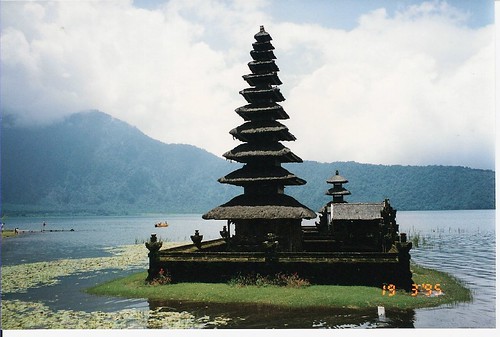Ancient Temples of Bali
By Mark Leger
The island is being eaten away. It may take millions of years before it's gone, but the sea is moving in. Responding to this oceanic island-eater, the Balinese believe that the ocean is home to the demonic forces of destruction. The mountains, the givers of soil and trappers of rain clouds, are the abode of the benevolent creators. Most every Balinese village has three temples, one oriented towards the interior mountains and dedicated to Brahma, the creator. Another in the center of the village dedicated to Vishnu, the preserver. And on the outside of town, towards the ocean is the temple to Siva, the destroyer.
In a twist on mainland Hinduism, the Balinese add a fourth, overarching deity, Sanghyang Widhi. And thousands of specific spirits, dwelling in mountains, lakes, special rocks, plants, your favorite cooking bowl. A highly resilient people, the Balinese have created an inspired mix of monotheism, Hinduism, and animism.
Although there's a lot of individual variation, most temples, called pura in Balinese, are usually comprised of two courtyards: a transitional outer and a sacred inner. The outer courtyard is entered through the distinctive Balinese split gates, called candi bentar. This is the place for larger assembly — cock fights, dance and gamelan performances, the preparation of offerings. Usually the outer courtyard has a kulkul tower, which is a kind of a bell tower, used for signalling to the villagers to come to temple functions or if something's awry in the village, such as a fire or a possessed postal worker. The inner courtyard is where the shrines and offering spots are located, and is frequently closed to casual visitors during temple festivals.
The best time to see a Balinese temple is during its festival, which is generally only once a year. But with some 20,000 temples on an island only 87 by 56 miles large, you'll have a lot of opportunity to see temple festivals. Since festival time is when the temple's deity comes to visit, it's important to look your best — kind of like when your rich and childless Uncle Henry pays a call. If you please him, he can do you big favors. But if you bore him, he's likely to forget about you just when you want to be foremost in his mind.
So show respect. Leave the tacky t-shirt and beat-up tennis shoes behind. Men will be asked to wear a temple sash, which you can frequently rent outside the temple gate, but it may make sense to buy one at market so you'll have one when rents aren't available. If you take pictures, do so respectfully. And treat the priests just like you would a cleric back home. When you're communing with the divine, you don't want camera flashes going off in your face. Also, it's hyper-bad form to be standing at a higher level than the priests during ceremony — so down off that ledge!
Unlike the Javanese monumental temples, Balinese temples have never been forgotten or forsaken. And what they lack in awesomeness, they make up for in charm and spiritual devotion. The best way to apprehend Balinese temples is not in the context of a few great sites, but as a broad network of significant nodes in a living, breathing, modern culture. The following temples are a taste of what's there. . .
Sunday, March 23, 2008
Pura Ulun Danu
Subscribe to:
Post Comments (Atom)

No comments:
Post a Comment